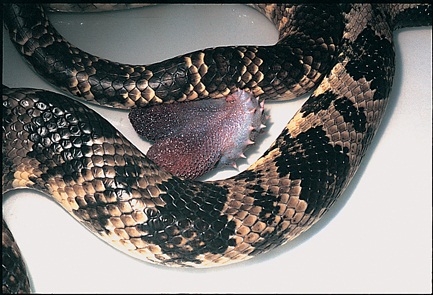Difference between revisions of "Reptiles and Amphibians Q&A 02"
(Created page with "[[|centre|500px]] <br /> '''This male snake is unable to retract one of his hemipenes into the postcloacal sheath on one side of his tail.''' <br /> <FlashCard questions="3">...") |
Ggaitskell (talk | contribs) |
||
| Line 1: | Line 1: | ||
| − | [[|centre|500px]] | + | [[File:Rep 02.jpg|centre|500px]] |
<br /> | <br /> | ||
Revision as of 17:47, 7 September 2011
This male snake is unable to retract one of his hemipenes into the postcloacal sheath on one side of his tail.
| Question | Answer | Article | |
| What is your diagnosis? | Prolapse of a hemipenis. |
[[|Link to Article]] | |
| What might be some of the potential aetiologies for this disorder? | One or both hemipenes may prolapse as a result of irritation or inflammation of the organ(s) or their sheath tissues, incarceration of the phallus by a foreign body such as a hair, the loss of neural control of the retractor penis muscle(s), or trauma to one or both retractor penis muscles. |
[[|Link to Article]] | |
| How should this condition be managed? | If possible, the prolapsed organ(s) should be cleansed and replaced back into its sheath(s). However, the prolapsed organ is often severely engorged and indurated; the topical application of glycerine or concentrated sucrose solution (not dry granules) may reduce the swelling sufficiently to permit a well lubricated hemipenis to be replaced. A purse-string suture is inserted in the pericloacal vent rim just tightly enough to prevent reprolapse but sufficiently loose to permit passage of urinary wastes and small stool boluses. The suture is usually kept in place for one week. If the prolapsed organ exhibits evidence of paralysis, infection, maceration or severe trauma, or if it cannot be replaced, amputation is necessary. If only one hemipenis is lost, the animal can still serve as a breeder. |
[[|Link to Article]] | |
